
|   |

|   |
 e-mail: sunilkothari1933@gmail.com Kathak Utsav: Showcasing of Kathak in Imphal Photos courtesy: Kathak Kendra December 14, 2018 Kathak Kendra, constituent body of Sangeet Natak Akademi, showcased Kathak in Krishna bhakti soaked Manipur on 28th and 29th November at Imphal with a view of interaction between two constituent bodies of SNA- Jawaharlal Nehru Manipur Dance Academy and Kathak Kendra. Indeed it was heartening to see this meeting of the Kathak gurus, exponents, faculty members of these two institutions and watch performances in an intimate setting during the inauguration of the renovated stage at JNMDA. The dignitaries, Kamalini Asthana, Chairperson of the Advisory Committee of Kathak Kendra, Prof H. Tombi Singh, Vice Chairperson, JNMDA, speaker of Manipur Legislative Assembly and Director of JNMDA, during the inauguration function mentioned that such performances bring artists from different dance traditions and regions closer through their art and serve the purpose of appreciation of its salient features, variety and also unity of culture. Kamalini Asthana also mentioned that whenever the artists of JNMDA visit Kathak Kendra in Delhi and display their Manipuri dances, they evoke a deep feeling of respect for the dance traditions. These exchanges therefore are very important and both the institutions aim to achieve this purpose. First day The opening number from the teaching faculty was by Abhimanyu Lal, a Jaipur gharana exponent, disciple of Guru Geetanjali Lal. In the time honored tradition of Kathak, Katha Kahe so Kathik kahave, one who tells a story is called Kathak dancer, Abhimanyu told the story of Draupadi chiraharan, disrobing of Draupadi by Dushasana, with vachikabhinaya and singing. The inevitable Mahabharata war was announced with punctuation telling about the five Pandavas and hundred Kauravas, the invitation for game of dice, Pandavas losing everything including Draupadi, and the humiliation suffered by Draupadi despite her five husbands watching helplessly. Draupadi begs of Krishna to save her. Pulling at never ending length of saris, Dushasana falls on the floor exhausted and Draupadi is saved from humiliation. But that becomes the cause of the war. Mahabharata war in inevitable, says the Kathakar. 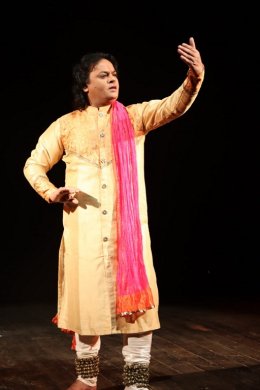 Abhimanyu Lal Abhimanyu sings in a melodious voice and renders dialogues with appropriate bhavas, suggests various characters subtly, be it five Pandavas by showing his palm with five fingers spread out, just a covering with scarf for Draupadi, limping Shakuni, spreading his arms for Dushasana, standing with index finger raised, holding Sudarshan chakra. Telling Mahabharata story is a signature of Abhimanyu. He has developed abhinaya using Vaishnav poems and is exploring thematic stories that project traditional Kathak. He has complete command over taal and laya. The unleashing of the fast tempo footwork, the ascending and the descending rhythmic variations are his forte. The judicious balance between mime and pure dance places him in a class of his own. The musicians, all staff members of Kathak Kendra, gave him excellent support. Malti Shyam is a seasoned dancer. She exudes confidence and one at once feels that here is a dancer who knows what to offer as her best. Malti's footwork is impeccable. Coming pat on sam is always a delight to watch. There is also an old world charm which is very attractive in her dance. In gat bhav, she enacted seeing through ghunghat (veil) in various ways. Of late one does not often see it being performed by majority of senior dancers. Malti invested beauty while lifting the ghunghat in various ways, depicting the nayika in different states of mind vis-à-vis the nayaka and danced with grace. Malti gave within half an hour excellent performance highlighting Lucknow gharana. One expected more from senior Guru Rajendra Gangani's group choreography. The four female dancers though well trained, somehow did not project their training in any impressive manner. The two young male dancers lacked coordination. I was later on told that one of the young boys had suffered leg injury and therefore while dancing he lost balance and fell down. Despite injury he continued dancing which did not help the overall design of the choreography. This feedback I hope will help both Rajendra and the disciples, so they can improve their presentation. 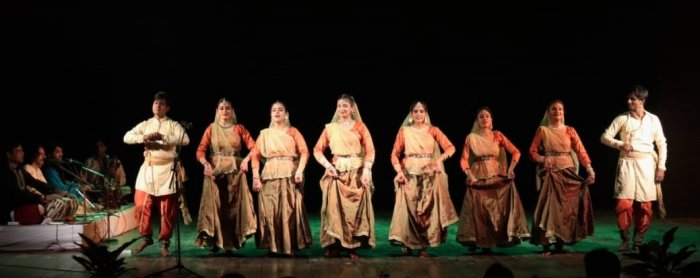 Rajendra Gangani's group Rajendra himself is a scion of Jaipur gharana. Dance is in his blood. Trained from young age by his legendary father Kundanlal Gangani he has imbibed the complexities of Jaipur gharana and its salient features. Therefore when he performs it looks faultless and be it his thaat or execution of parans, footwork, pure dance, one enjoys his dancing. It was a pleasure to see the gliding on the floor, with feet moving in unison, creating an illusion of his entire body moving in one direction. It reminded me of having seen his illustrious father dancing, clad in pyjama, which used to move imperceptibly on the floor. The traditional Ganesh Kavit gam gam Ganapati, the hallmark of Jaipur gharana was performed with variations displaying the flair of the gharana. Besides nritta numbers, Rajendra performed a bhajan. However, I felt that he did not put himself hundred percent into his performance. He is capable of scaling great heights. I have seen his performance at Shimla Festival where his abhinaya to a bhajan was extremely moving and he looked soaked in bhakti. It would be great to see him performing with that intensity. 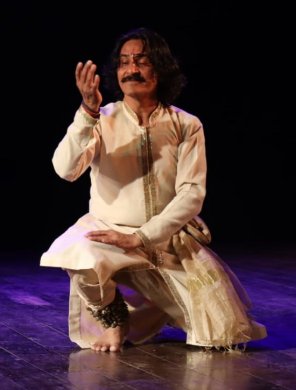 Rajendra Gangani 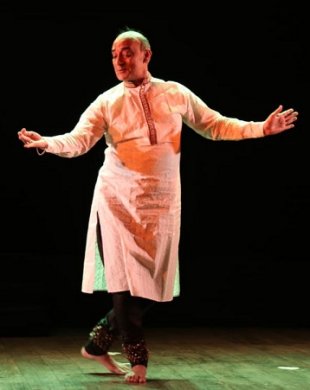 Subhash Chandra Second Day Subhash Chandra has received training from the legendary Mohanrao Kallianpurkar for several years. He represents his Guru's talim, training faithfully. After a prayer composed and choreographed by Rohini Bhate, he presented pure dance aamad with grace and unhurried pace. Then followed abhinaya to a thumri of Maharaj Bindadin, "Kahe rokat dagar payer Nandalal more?" (Why do you block my way, O dear Krishna?) He sat down as is tradition of baithki bhava, doing abhinaya while performing sitting. It is in this aspect that Subhash excels. His netrabhinaya, expressions through the eyes, gentle movements of the palms and arms, suggesting path, beseeching Krishna to let her go, found a felicitous expression. Indeed it had old world charm of seeing abhinaya expounding slowly but creating rasa, that indefinable term of relish. Subhash drowns himself in performing abhinaya. There is a lot of 'sukun', feel of quiet in his dancing. There is no bravado or showing off. His presentation left an indelible impression. However, one knows that times are changing and there are few takers of this aspect of dancing. But it is important to showcase this aspect of abhinaya to young generation. After Subhash's presentation two young female dancers, both disciples of Rajendra Gangani, Sonia Gupta Rao and Samiksha Sharma performed solo. Sonia Gupta Rao performed competently, her nritta in Kathak repertoire had distinct stamp of Jaipur gharana, her dance was sober and appealing. Her Shiva stuti describing the ash besmeared body of the god and various ornaments including crescent moon, his matted locks from where flows river Ganga, the serpents which are on his arms and around his neck and Lord Shiva's vehicle Nandi, were performed with devotional mood. Her thaat, aamad and other numbers were danced grammatically in correct way. She would benefit to infuse her dance with more joyous approach. 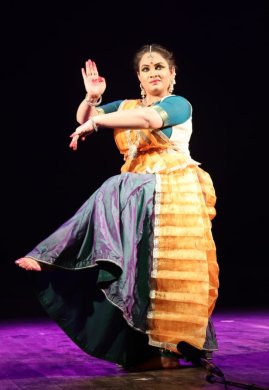 Sonia Gupta Rao 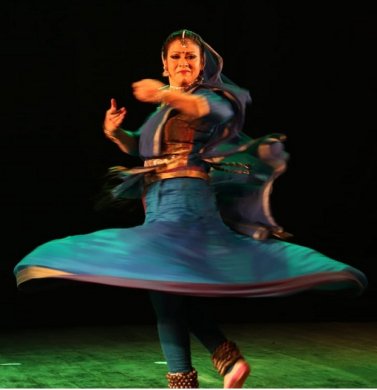 Samiksha Sharma Samiksha Sharma entered the stage in fast tempo and whatever she performed was in druta laya, fast tempo. It was a different approach and keeping with the current trend of fast space, several chakkars and scintillating footwork. That she has mastered the technique under the guidance of her Guru Rajendra Gangani, there was not the slightest doubt and she performed with aplomb. Her Shiva Stuti was the same as performed by Sonia and described the various ornaments adorned by Lord Shiva but in its execution there was certain restlessness, which informed her dancing throughout. There was finesse in her endings and coming pat on the sam which won her rounds of applause. In particular with chakkars on one leg, eka pada bhramari, that she has mastered well. The thaat, pure dance numbers were therefore full of chamak, quick silver quality. Suradas bhajan was full of vatslya, motherly love, Yashoda looking for Krishna, offering him butter, decorating him with ankle bells, peacock feather, pitamber and putting kajal, black spot on his cheeks. Playing with him lifting him on her back, making him walk holding his little fingers et al was performed with charm. Surdas says that even for getting a glimpse of the divine lord, the gods and the saints consider themselves fortunate, look at the luck of the milk maids who feed Krishna with love. Samiksha Sharma is a bright dancer. What she has to maintain is a balance between abhinaya and nritta. Speed is welcome but excessive speed is not always enjoyable. There should be moderation. Then it serves its aesthetic purpose. The group dance choreographed by Jai Kishan Maharaj on the theme of Rasalila on full moonlight was highlight of the concluding number. All the charming young dancers performed with complete involvement. Jai Kishan Maharaj being the son of Pandit Birju Maharaj and trained by him from very childhood, the stamp of Lucknow gharana was evident in the groupings, the delicacy and beauty of the 'ang' and execution of various footwork. The two dancers enacting Krishna and Radha looked a lovely pair, sitting under the Kadamb tree. The recitation of the poem written by Jai Kishan Maharaj and singing by Brijesh Mishra were appealing. Jai Kishan Maharaj transported us to bowers of Brindavan where Gopis were looking at Krishna with Radha. Then they all played Raslila which stole hearts of even the gods and Gandharvas. The entire presentation was charming. Since the dancers looked very young, there was certain innocence which was appealing. Jai Kishan Mahraj has very commendable sense of group choreography. The duet between Krishna and Radha was performed with enchanting movements. Overall impression was of joy on a full moon night, Gopis and Radha and Krishna performing Rasalila. The Kavits and the songs were appropriate and enhanced the visual appeal. 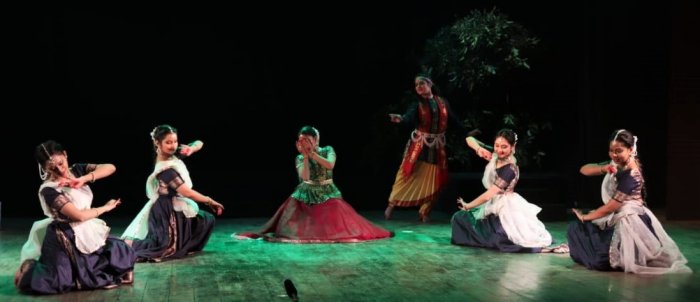 Jai Kishan Maharaj's group Jai Kishan Maharaj was requested to perform abhinaya in the end. Like his father Pandit Birju Maharaj, he sat on the takhat, musicians on either side of him. His ada and movements reminded one of Birju Maharaj, which is natural. The abhinaya to Bindadin Maharaj's thumri and to other compositions was within the traditional framework. The pun on word Hari and its different interpretations were engaging. He has a great tradition he has inherited from his ancestors. He also writes poems in the same vein as his ancestors and carries on the tradition further. He is pleasantly plump and with cherubic face he wins over his audiences. I was very pleased to see the performances of the young generation. Having seen the great maestros one often wonders would there be someone like them from young generation, but one need not despair. Such a great tradition would find its own masters who would carry the tradition further. Along with the two day Kathak Utsav, a special workshop was conducted in Kathak for the local students of JNMDA by Nalini Asthana, disciple of Guru Jitendra Maharaj. It was indeed very heartening to see the more than 20 young female Manipuri dancers and few boys who had turned up at 8am in the morning for the workshop in Kathak. They were quick in learning the steps and movements. Being dancers they found it easy to pick up the movements with 16 beats teen taal and also take chakkars. Nalini has a way to explain the torso movement in Kathak, the way hands have to be moved along with body turns and manage saushthav, erect position. Also how to move eyes with hands. The dictum Yato hastaha tato drishti, yato dristi tato manah, yato manah tatobhavaha, tato bhavaha tato rasa was explained to them with demonstration. In Manipuri, facial expressions are minimal and emphasis is on angikabhinaya, through entire body, whereas in Kathak the face becomes the playground of various emotions. This difference was well explained by Nalini. Such workshops open up minds of other dance practitioners and offer an insight into the subtle nuances of other dance forms.  Dr. Sunil Kothari is a dance historian, scholar, author and critic, Padma Shri awardee and fellow, Sangeet Natak Akademi. Dance Critics' Association, New York, has honoured him with Lifetime Achievement award. Post your comments Please provide your name and email id when you use the Anonymous profile in the blog to post a comment. All appropriate comments posted with name & email id in the blog will also be featured in the site. |